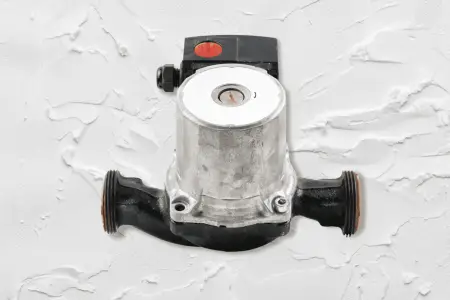Whether you’ll be traveling this winter in an RV or will be sitting at home with no intention of stepping out until it’s absolutely necessary, one thing is sure: a hot water recirculation system will keep your pipes from freezing, saving you some costly repairs and much headache.
Pipes freeze due to the coming together of two things: frigid weather and stagnant or slow-moving water. A hot water recirculation system prevents this union by keeping warm water moving in the pipes, even when you don’t open the hot water faucets. This keeps your pipes from freezing.
What is a Hot Water Recirculation System?
Hot water recirculating systems keep hot water moving through pipes to ensure you get it at the faucet immediately. A secondary benefit of hot water recirculation systems is that they keep pipes from freezing.
- The recirculating pump uses a heavy-duty stainless steel pump head with...
- System includes pump, 24hr programable timer, sensor valve with thermal...
- Extremely quiet and energy efficient this system supplies instant hot water...
- A sensor valve opens when the water on the hot water side cools, pushes the...
- Pump mounts directly onto water heater, can be used with all types of pipe,...
A hot water recirculation system consists of a pump that keeps water moving, a check valve to prevent water from flowing backwards and a timer to let you decide when you want the pump to turn on. Some systems also have a temperature sensor to turn the pump off when the water is hot enough.
Here are various types of hot water recirculation systems:
1) Traditional Hot Water Recirculation System
In traditional circulating systems, your plumber installs a new return line from the fixture installed the farthest away from the water heater. The other end of this plumbing line is at the water heater. This means it carries cold water to the water heater to warm it up.
These systems do a fine job of keeping your pipes from freezing, but at the cost of higher running costs. That’s because they continue to consume electricity, whether you’re using hot water or not. So they might keep your pipes from freezing but may also send your electricity bills through the roof.
2) Instant Hot Water Recirculation System
An instant hot water recirculation system lacks the return pipe for cold water. Instead, with these systems, a pump is installed under the faucet or over the water heater. This pump sends pressurized water to the cold water lines, while a check valve ensures the hot water stays at the taps.
Hot water recirculation systems are one of the best ways to keep your pipes from freezing. Unlike their traditional counterparts, they don’t use much water to keep the pipes warm. Plus, they won’t consume any electricity while sitting idle, bringing down your energy costs.
3) On-Demand Hot Water Recirculation System
On-demand hot water recirculation systems do not have timers. Instead, they rely on you to manually turn on the pump as needed. Once your hot water demands are met, you can turn off the pump to save energy. These systems can be instant or traditional hot water recirculation systems.
Similar to on-demand recirculation systems, these too do a fine job of keeping your pipes from freezing and not letting much hot water go to waste.
4) Gravity-Fed Hot Water Recirculation System
Gravity-fed recirculation systems don’t rely on a pump to recirculate water. You just have to make sure that the hot water pipe is installed above the water heater. Then, once you open the hot water faucet, cold water will exit the tank, pass through the heater and get warmed up.
What are the Benefits of Hot Water Recirculation Systems?
Here are the key benefits of installing a hot water recirculation system:
Saves Time
A hot water recirculation system saves time by ensuring you don’t have to wait for much longer for warm water after opening the faucet. It does that by keeping hot water within a few feet of each faucet.
Safeguards Your Health
Did you know that stagnant cold water can quickly become a hub for Legionella? Hot water recirculation system keeps the water’s temperature from cooling to a point at which Legionella could grow.
Saves Water
According to the US Environmental Protection Agency, an average household can waste up to 180 gallons of water per week. Water recirculation systems may bring down this number by reducing hot water waste.
What are the Drawbacks of Hot Water Recirculation Systems?
Here are the major drawbacks of hot water recirculation systems:
- Newer units cost more upfront. You might have to spend as much as $200 on purchasing a hot water circulation system, with the pump contributing the most to the cost.
- Older units consume more electricity. Looking to offset the initial cost by buying a 2nd hand unit? Don’t do that. Older units are less efficient and consume more electricity, as they operate around the clock. This means they consume electricity even when you aren’t using them, adding to running costs.
- Sensor valve requires regular replacement. These systems require you to install a sensor valve, either at the sink farthest from the heater or beneath the pump. Homeowners complain that the valve requires replacement every 1 to 2 years, adding to the system’s running costs.
Don’t think you’d buy a hot water recirculation system now that you’ve read their drawbacks? Don’t worry as in the next section we’ve given you alternatives.
How to Keep Pipes from Freezing in Cold Weather
Apart from using a hot water recirculation system, here are other ways to keep your pipes from freezing:
Keep the heat on
Most people turn off the heat once they leave their home. Most people, as it turns out, return home to frozen or, in some cases, burst pipes. Which is why it’s always a good idea to keep the heat on in your property.
Let the faucet drip
If you were paying attention during your physics class in high school, you might remember that moving water doesn’t freeze. Letting the faucet drip will give you a practical demonstration of this concept.
Apply heating tape
A heating tape, as you’ll see in the next section, works both ways. You can count on it to keep the pipes from freezing. And if you don’t and the pipes do end up frozen, wrapping a heating tape around them may force them to thaw.
Add extra insulation
Provided it gets frigid in your part of the woods during the winter, you may want to add extra insulation around the pipes. Popular insulation choices include fiberglass sleeves and foam rubber.
How To Thaw Frozen Water Pipes
If you do find your water pipes are frozen, here are some tips to unfreeze water pipes and prevent costly damage:
Use a hair dryer
Turn on the hair dryer and aim it at the pipe portion closest to the faucet. Make sure the dryer’s heat is set at ‘medium’ setting. Take all the necessary precautions and avoid coming into direct contact with the pipe.
Use a heat lamp
Turn on the heat lamp and aim its face towards the pipe. The distance between the lamp and the pipe should be minimal so that the lamp’s heat can reach the pipe. This indirect heat might quickly unfreeze a pipe.
Use electrical heating tape
Wrap an electrical heating tape around the pipe. Some heating tapes let you plug them in and unplug them when needed. Others, meanwhile, shut off on their own. Both can thaw a frozen pipe by distributing heat through it.
Use hot towels
Looking for a homemade solution? Warm up some water, soak a few towels in it and then wrap the hot towels around the pipe. This option might not work as quickly as those mentioned above, but it may slowly unfreeze the pipe.
Conclusion
A hot water recirculation system will keep your pipes from freezing. However, if the damage has already been done and you’re looking for a way to thaw frozen pipes, a hair dryer, heat lamp or heating tape might save you from some costly repairs.

I graduated with a degree in Chemical Engineering and have written for a number of nationally recognized publications in the home improvement space. My skills include fluid mechanics and process engineering and I have worked on numerous projects, including in waste water flow rate calculation and heat balance of steam rollers in the paper industry. My goal as a technical writer is to make complicated topics easy to understand for the average person.

